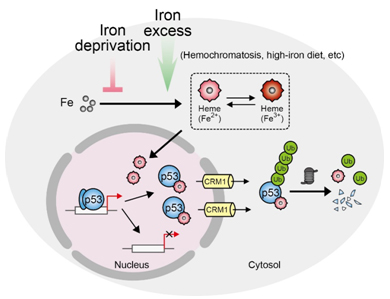New Study Reveals Mechanism of Iron Metabolism in Regulating Tumorigenesis
Source:
Time: 2015-09-20
Hereditary hemochromatosis is a genetic disorder that has iron overload and affects nearly 1 in 300-400 people in the United States alone._ENREF_15_ENREF_22 Clinical complications in hemochromatosis patients typically include liver cirrhosis, and up to 20-200 fold increased risk of hepatocellular carcinoma or other types of cancers, with underlying mechanisms yet elusive. Meanwhile, Iron deprivation, such as iron chelation, has emerged as a major strategy for chemotherapy. However, iron deprivation could suppress selected types of human malignancies but exert no effect on other types of cancers, with mechanisms unclear.
Jia Shen and his colleagues from a research group led by Prof. Hu Ronggui at the Institute of Biochemistry and Cell Biology, Chinese Academy of Sciences, identified tumor suppressor p53 protein (p53) is downregulated during iron excess. The iron polyporphyrin named heme, binds to p53 protein, interferes with p53-DNA interaction and triggers nuclear export of p53 followed by cytosolic degradation. Furthermore, iron deprivation suppresses tumor largely in dependence of wild-type p53, suggesting that upregulation of wild-type p53 signaling might critically underlie the selective efficacy of iron deprivation.
This study entitled “
Iron metabolism regulates p53 signaling through direct heme-p53 interaction and modulating localization, stability and function of p53” was published online in
Cell Reports on Feb 27, 2014. This work supported by grants from the Chinese Academy of Sciences, the 973 program of the Ministry of Science and Technology of China, the National Natural Science Foundation of China, Cancer Center of Xuhui Central Hospital, Shanghai Institute of Neurosciences and the Science and Technology Commission of Shanghai Municipality.

A schematic depiction of how iron/heme metabolism might regulate p53 signaling (Image by Prof. HU Rongui’s group)

 Appendix:
Appendix: